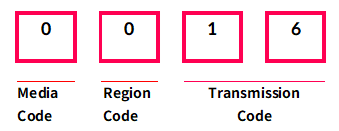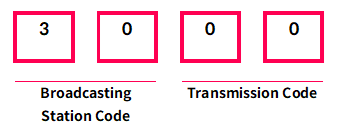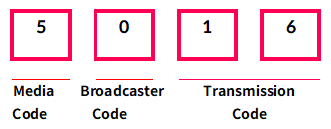BACKGROUND
This document provides guidelines for utilizing Transmitter Identification (TxID) codes in South Korea. The goal is to help identify individual ATSC 3.0 transmitters within a Single Frequency Network (SFN). The technical specifications of the TxID codes are based on TTA's Technical Report from South Korea TTAR-07.0026/R1, titled "Guideline for Transmitter Identification (TxID) and Broadcast Stream Identifier (BSID) Assignment of Terrestrial UHD Systems," which was approved on November 1, 2018, and is available on the TTA website here.
In an SFN, multiple transmitters share the same frequency. To differentiate between these transmitters, a unique TxID code is assigned to each. This code is used in ATSC 3.0 transmission system equipment, such as Broadcast Gateways (BGWs), Exciters, and professional monitoring receivers. It is not applicable to consumer receivers.
No particular authority or methodology for assigning or registering these identifying codes is suggested by the ATSC 3.0 standard. While TxID code table (link below) is a voluntary register for the TxID transmitter identification system, it is recommended to adhere to the guidelines to avoid potential conflicts.
TABLE SPECIFICATIONS: TxID Allocation Rules for Each Broadcaster
This section outlines the allocation rules for TxID codes for each terrestrial broadcaster in South Korea.
KBS, EBS, OBS

A TxID code is a four-digit number with the following structure:
- Thousand Digit (Media Code): Identifies the media organization (e.g., KBS, EBS, OBS).
- Hundreds Digit (Region Code): Differentiates broadcasting regions.
- Tens and Ones Digits (Transmission Code): Distinguishes between main transmitter, high-power and relay transmitter.
Media Code (Thousand Digit)
| Media Name | KBS1 | KBS2 | EBS | OBS |
|---|---|---|---|---|
| Media Code | 0 | 1 | 2 | 6 |
Region Code (Hundreds Digit)
| Category | Region Code |
|---|---|
| Metropolitan area (head office) | 0 |
| Busan | 1 |
| Gyeongnam (Changwon) | 2 |
| Gyeongbuk (Daegu) | 3 |
| Jeonnam (Gwangju) | 4 |
| Jeonbuk (Jeonju) | 5 |
| Chungnam (Daejeon) | 6 |
| Chungbuk (Cheongju) | 7 |
| Gangwon (Chuncheon) | 8 |
| Jeju | 9 |
Transmission Code (Tens and Ones Digits)
- Main Transmitter: 00
- High-power Transmitter: 00-19
- Low-power Transmitter: 20-99
MBC
To differentiate MBC and all local MBCs from other large-scale codes, the thousands digit of the media code is assigned as 3 or 4.

Broadcasting Station Code (Thousands and Hundreds Digits)
The broadcasting station code is a 2-digit code ranging from 30 to 49.
| Broadcasting Station | Code | Broadcasting Station | Code |
|---|---|---|---|
| MBC (Metropolitan) | 30 | Chuncheon MBC | 40 |
| Busan MBC | 31 | Ulsan MBC | 41 |
| MBC Gyeongnam (Changwon) | 32 | MBC Gyeongnam (Jinju) | 42 |
| Daegu MBC | 33 | Pohang MBC | 43 |
| Gwangju MBC | 34 | Yeosu MBC | 44 |
| Jeonju MBC | 35 | Mokpo MBC | 45 |
| Daejeon MBC | 36 | Andong MBC | 46 |
| MBC Chungbuk (Cheongju) | 37 | MBC Chungbuk (Chungju) | 47 |
| MBC Gangwon Yeongdong (Gangneung) | 38 | MBC Gangwon Yeongdong (Samcheok) | 48 |
| Jeju MBC | 39 | Wonju MBC | 49 |
Transmission Code (Tens and Ones Digits)
The transmission code '00' is assigned to the main broadcasting station in the region. Low-power stations use codes 01 to 19, and relay stations use 20 to 99. When adding new transmitters, especially UHD transmitters, the same transmission code as KBS is used whenever possible to minimize confusion.
SBS Network

Media Code (Thousands Digit)
To differentiate SBS and local private broadcasters from other large-scale codes, the media code is assigned as 5.
Broadcasting Company Code (Hundreds digit)
Broadcasting company codes numbered from 0 to 9 are assigned to SBS and local private broadcasters.
| Category | Broadcaster Code |
|---|---|
| SBS(Seoul) | 0 |
| KNN(Busan) | 1 |
| TBC(Daegu) | 2 |
| KBC(Gwangju) | 3 |
| TJB(Daejeon) | 4 |
| UBC(Ulsan) | 5 |
| CJB(Cheongju) | 6 |
| JTV(Jeonju) | 7 |
| G1(Chuncheon) | 8 |
| JIBS(Jeju) | 9 |
Transmission Code (Tens and Ones Digits)
Among the transmitting station codes, ‘00’ is assigned to the ‘broadcasting station’ in the relevant area.
By distinguishing between main station and simple station facilities through the criteria of assigning 00 to 19 for main station and 20 to 99 for simple station, even when expanding new transmission and relay stations, ensure that the transmission code of ‘station’ and ‘simple station’ are not mixed.
In the case of existing sites, the principle is to use the same transmitting station code as KBS. However, the Busan/Ulsan area is an exception. In the case of a new site, its own transmission code is assigned according to the above standards.
USE OF THE TABLE: TxID Application, Operation, and Verification
This chapter outlines the procedure for applying TxID to individual transmitters, verifying the application results, and operating the system. For detailed information on specific TxID assignments for each transmitting station, please refer to the TxID Assignment Table.

1. Apply TxID to Transmitter
TxID Input: After installing a transmitter or repeater at a transmitting or relay station, input the four-digit TxID value assigned in the TxID Assignment Table into the TxID setting section of the exciter's control screen.
Example: When installing a KBS2 transmitter at the Hwangnyeongsan transmitting station, input the TxID 1100 assigned in the TxID Assignment Table
Backup Device: If a backup device is present, enter the same TxID value for both the main and backup devices.
Example: For a main/backup configuration of the Busan MBC transmitter at the Hwangnyeongsan transmitting station, input TxID=3101 into both the main and backup devices.
2. TxID Operation
TxID Activation: TxID information is inserted and transmitted as a watermark in the time domain during the transmission of the main broadcast signal. TxID transmission can be activated or deactivated selectively based on the broadcaster's needs. It can be continuously transmitted or activated only during specific periods, such as field testing or transmitter inspection.
TxID Control: TxID activation can be controlled in two ways:
- STL Mode: This centralized control method is managed by the Broadcast Gateway (BGW). After inputting the TxIDs of all transmitters controlled by the BGW into the system, individual transmitters or groups of transmitters can be activated or deactivated by modifying the TxID Injection Level Code through the BGW management screen. The TxID Injection Level Code is set to 0000 (OFF) or another value (ON) for each transmitter.
- Manual Mode: The operator directly accesses the management screen of each exciter and controls the activation of the individual transmitter's TxID by modifying the TxID Injection Level Code, regardless of the BGW's control settings.
TxID Insertion Level: The TxID insertion level can be independently determined within the specified range of the standard, considering detection conditions, reception conditions, and operating requirements. However, it is recommended to set the maximum TxID insertion level to a value that minimizes interference with the broadcast signal, taking into account the current preamble L1 signaling transmission mode, as shown in the table below:
| |
L1-Basic Mode | L1-Detail Mode | ||||||||||
|---|---|---|---|---|---|---|---|---|---|---|---|---|
| 1 | 2 | 3 | 4 | 5 | 1 | 2 | 3 | 4 | 5 | 6 | 7 | |
| Insertion Level (dB) | -15 | -18 | -21 | -24 | -27 | -15 | -21 | -24 | -24 | -27 | -33 | -36 |
Based on field test results in the Seoul area, it is recommended to set the TxID insertion level at -24 dB or higher for normal TxID detection in areas with overlapping SFN signals.
3. Check TxID Application Results
After activating TxID, the results of the TxID application can be verified using the following methods. For STL mode, all conditions must be checked, while for MANUAL mode, only items ③ and ④ need to be checked.
- ① Verify that all transmitter TxID information managed by the Broadcast Gateway is entered in the TxID section on the Broadcast Gateway management screen, and that the TxID Injection Level Code for each individual TxID is set to 0000 (OFF) or another value (ON).

- ② Connect the STLTP monitoring device to the BGW output or exciter input as shown in Figure 1, and use the Per_Transmitter_Data() signaling A/324 Timing and Management Stream Packet Payload. Verify that the received information matches the settings for all TxIDs entered in the BGW.
- ③ Check whether the Injection Level set for the relevant transmitter is displayed correctly in the TxID item of the exciter management screen. If the transmitter exciter responds correctly to the TxID value entered during installation, the Injection Level entered by the BGW or operator will be displayed correctly.

- ④ After entering one or more TxID values to be observed into the ATSC 3.0 Professional receiver, as shown in Figure 1, check whether there is a detection response (peak) at the corresponding TxID values in the received RF signal. If the TxID information is correctly inserted and transmitted in the output RF signal of a transmitter with TxID transmission activated, an impulse response will be observed in the time domain Channel Impulse Response detection result, as shown in Figure 4.

